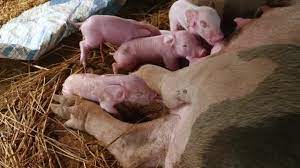
Swine Pregnancy Calculator
Estimate when your swine is due to give birth by entering the date of the first mating below and stay prepared for additions of new calves to your family!How Long Are Swine Pregnant?
The average litter size of piglets per birth is 7. However, it is not uncommon to find a swine having as many 14 piglets in one farrowing. The large litter sizes make swine pregnancies and deliveries potentially complicated. As a result, adequate care for the sake of the swine and fetuses is crucial.
Swine are typically pregnant for about 115 days. While it is possible for the pig to deliver piglets as early as 100 to 110 days, the risk of complications for piglets born this early are much higher than those delivered at term.
In the sections below, you will learn everything you need to about swine pregnancies including what to expect from the swine, what's going on within their wombs, and how to best take care of them. Furthermore, we shall take a look at the equally important farrowing and post-partum stages and the specific needs your swine may have.
Week 1 and 2 (Day 0 to 14)
What to expect
Day 0of the swine's pregnancy is counted as the day that the pig is on heat and either mates or is artificially inseminated. The heat period lasts about 8 to 24 hours.
This offers a very narrow window for successful fertilization. To help improve success rates for planned breeding, here are some signs that a swine is in heat.
- Restlessness
- Red, swollen vulva
- More receptive to mounting
- Reduced appetite
Once there is successful breeding and fertilization, the newly-formed embryo migrates to the uterus and attaches to the wall by day 11.
Something interesting about swine pregnancies is that more than 4 swine embryos need to attach to the uterus for the pregnancy to be recognized. If they are fewer than this, the swine will be back on heat in about 3 weeks.
Another important milestone during the first 2 weeks of the swine's pregnancy is placenta formation which starts at around day 11 and is usually complete by day 15.
With the embryo being just a small ball of cells, there are no changes to be observed in the swine both physically and behaviorally.
How to care for the swine
The swine is very low-maintenance during the first two weeks of their pregnancy. Just keep them on a balanced and appropriately portioned diet for their weight.
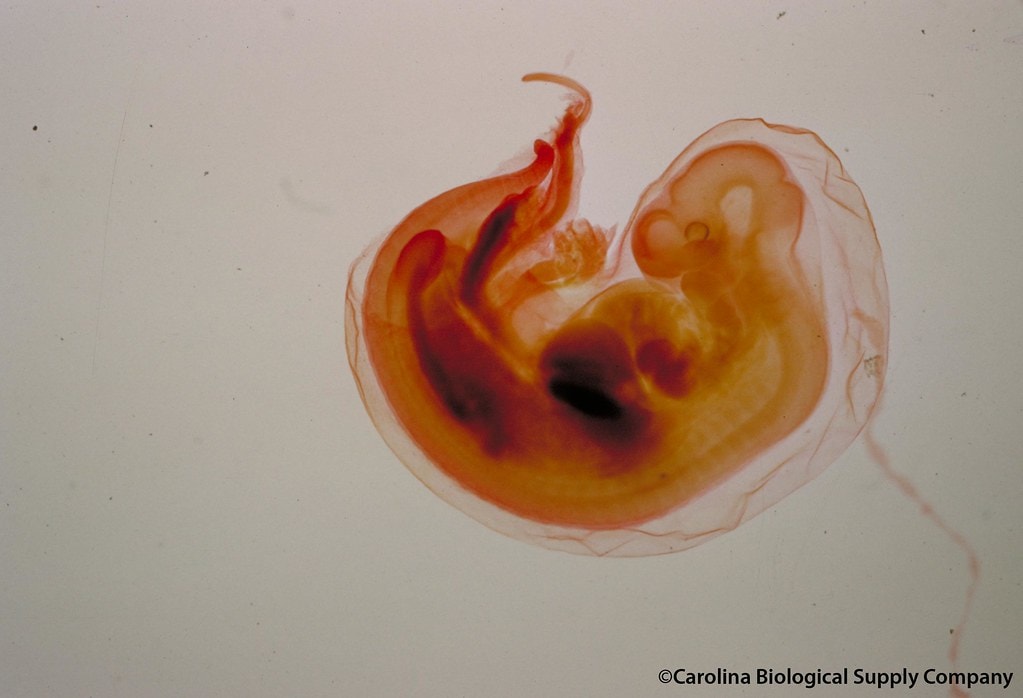
Week 3 and 4 (Day 15 to 28)
What to expect
The 3rd and 4th weeks of the swine's pregnancy are marked by rapid cell growth of the embryo. By day 21, the embryo has developed into a fetus that bears a closer resemblance to the final piglet product. Day 21 also marks the start of development of muscle fibers in the fetus.
The fetus' individual placentas continue to expand for more access to the resources that each fetus needs to survive and develop.
For the most part, there are no obvious changes to pick up on with the swine. However, if you are keeping track of their weight you will notice a steady increase. There may also be an increase in the appetite.
Day 28 is important in swine pregnancies as this is where ultrasounds start to be of diagnostic value when it comes to confirming the pregnancy.
How to care for the swine
With the onset of muscle development in the fetuses, you need to ensure that the swine is consuming enough amounts of amino acids. Soy beans are a great source of these much needed proteins.
Whole grain cereal feeds are also a good source of amino acids for both the swine and their fetuses.
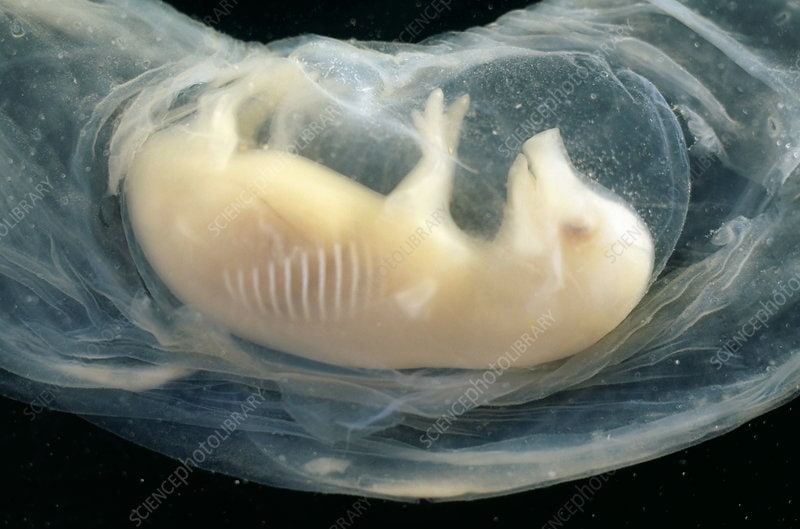
Week 5 and 6 (Day 29 to 42)
What to expect
Week 5 and 6 of the swine's pregnancy are considered the beginning of the mid-pregnancy stage. Here, there isn't a lot to expect in terms of weight and size changes for either the fetuses or the swine. However, the fetuses go through a lot of specific differentiation.
Day 35 is particularly important as it marks the start of specific organ development including the digestive tract, lymphatic system, and skin appendages. Day 35 is also when most bones start to get calcified. These changes can be picked up on ultrasounds very easily.
On the swine's part, it will start to become much clearer that they are pregnant. They will be heavier and the abdominal girth will be more markedly increased.
Furthermore, the hormonal functions of the placenta will also start to produce behavioral changes in the pregnant swine. These include:
- Increased appetite
- Mood swings with periods of increased affection and others where the swine is aggressive.
- Aversion to male pigs in the same environment.
How to care for the swine
These 2 weeks are very important in the swine's pregnancy as this is one of the periods where the risk of intrauterine fetal death is highest. Due to the calcification, the dead fetus cannot be reabsorbed and instead gets mummified and delivered with the rest of the piglets.
The exact causes may not be known but adequate care of the swine is very important to ensure survival of the fetuses.
This includes keeping the swine on a healthy diet, reducing any work load they may have, and keeping them safe. That last part includes minimizing handling and keeping the swine away from aggressive pigs.
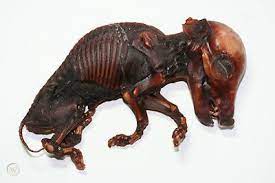
Week 7 and 8 (Day 43 to 56)
What to expect
Week 7 and 8 in the swine's pregnancy are generally uneventful for both the swine and the fetuses. The most important milestone is at day 50 by which most muscle groups in the fetuses are fully formed.
The swine, on the other hand, continues to increase in weight and appetite levels. However, you may not have to increase their food portions just yet as the fetus is not going through a lot of growth at this stage.
How to care for the swine
Fortunately, the risk of spontaneous fetal demise is much lower during the 7th and 8th weeks of the swine's pregnancy. It may have something to do with the fact that the fetuses are stronger and better developed.
Whatever the case, maintain the swine's healthy diet and stress-free environment for a more favorable pregnancy outcome.
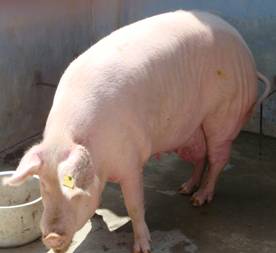
Week 9 and 10 (Day 57 to 70)
What to expect
Week 9 and 10 of the swine's pregnancy can best be described as the calm before the growth storm. By day 56, the fetal skeleton is fully formed and calcified. The fetuses at this stage begin to resemble fully-formed piglets.
The growth of the fetuses is still somewhat slow with most measuring about 80mm by day 68.
Due to the increased appetite and gradually increasing size of the fetuses, the swine will continue to get larger. You may also notice that the swine is slower and less agile than they were before the pregnancy. Furthermore, they are less inclined to engage in fights.
This is likely a protective instinct over their fragile, growing fetuses.
How to care for the swine
At this stage of the pregnancy, the swine's nutritional needs are high and about to get much higher as the fetuses are about to go through a growth spurt. It may therefore be best to start increasing their food portions during the 10thweek.
We recommend an increase of about 1/2 lbs per day. However, the exact amount depends on the size of the pig and the number of piglets. It is therefore best to consult a veterinarian if you feel inadequately experienced to make the decision.
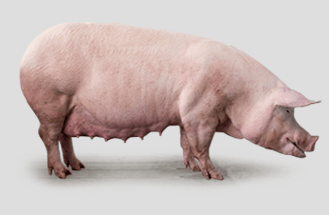
Week 11 and 12 (Day 71 to 84)
What to expect
Last 2 weeks of what is referred to as the mid-pregnancy
Day 75 dramatic increase in the weight and size of fetus. Same changes reflected on weight and abdominal girth of the swine
Day 77 to 84 the lymphatic and circulatory systems fully developed. Blood, lymph, spleen, liver, thymus. Blood cells formed
Marked increase in weight and size swine. Increased growth of mammary glands. Swollen. The abdomen may be asymmetrical
How to care for the swine
Increase feeds by about ½ to 1 pound per day. However, consult your vet
Ensure nutritional balance as there is a lot of growth and development still. Carbs, amino acids, fiber, micronutrients.
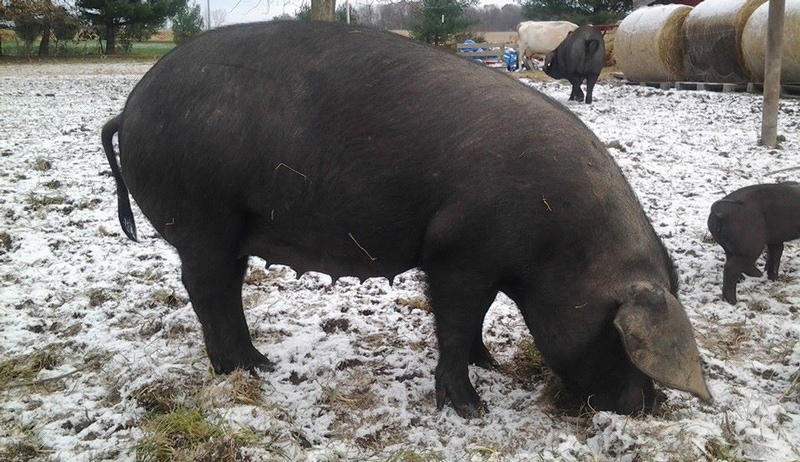
Week 13 and 14 (Day 85 to 98)
What to expect
Day 85 marks the beginning of late pregnancy in the swine. This is arguably the most critical time for both the swine and the fetuses. This is because the fetuses undergo a dramatic increase in size and weight.
By day 98, the fetus will be about 200mm in length. This is more than 2 times their size by the end of week 10.
In addition to the increase in size, the fetuses also go through most of the final stages of development during these two weeks. In fact, the pig fetuses are considered almost fully developed by day 90 of the pregnancy. However, the lungs at this stage are not mature enough to support life outside the womb.
The growth spurt that the fetuses experience spills over to the size and weight of the swine. There is also a marked increase in the girth of the swine's abdomen. The enlargement of the abdomen is more often than not symmetrical at this stage.
How to care for the swine
While it is important to ensure that the swine is adequately fed to keep up with the increasing demands, it is important to appreciate the risks of overfeeding. Therefore, consider reducing the feed volumes to just a bit more than what you were feeding the swine in early pregnancy.
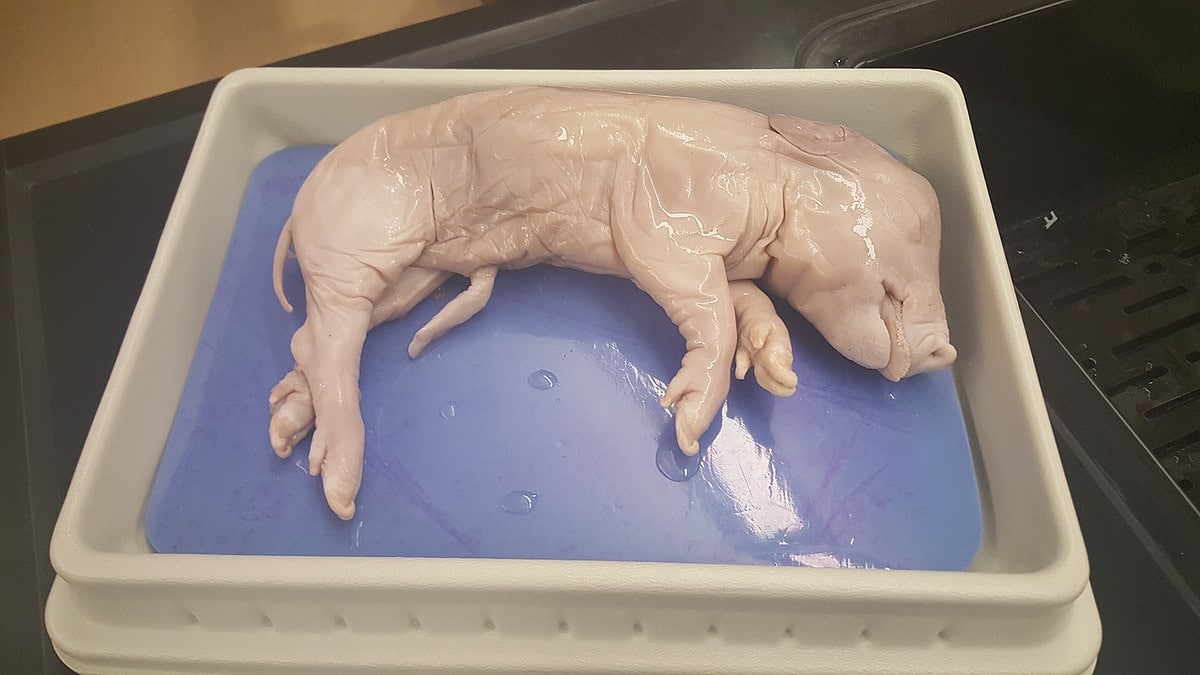
Week 15 and 16 (Day 99 to 115)
What to expect
The last two weeks of the swine's pregnancy are marked by some increase in weight and size for both the fetuses and the swine.
The distention of the swine's abdomen will likely get more asymmetrical as the larger fetuses settle into their pre-farrowing positions. In some cases
Most changes are seen within the last week between day 105 and the delivery. Some of these changes include increased size of the mammary glands. They may be swollen and red and tend to stand perky against the abdomen. The underbelly may also get saggy.
The enlarged mammary glands may also produce some milk when squeezed during this last week of the swine's pregnancy.
About 24 to 48 hours to delivery, you will also start to notice warning signs that the swine is ready to undergo farrowing. Here are some of these telltale signs.
- Increased vocalization.
- Restlessness despite low energy levels.
- Self-seclusion with nesting behavior.
- Vulval discharge that is usually bloody.
How to care for the swine
Caring for the swine during the last 2 weeks of their pregnancy is about ensuring that they are comfortable, well-fed, and have a clean spot to nest and prepare for the farrowing.
It is also best at this point to get a vet on board to examine the swine or to be on call in case of an emergency.
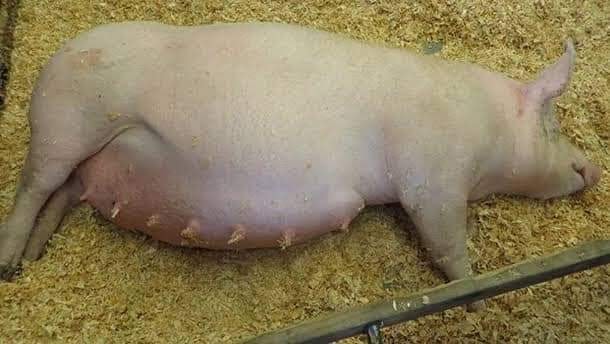
Farrowing
What to expect
Farrowing refers to the process by which the swine delivers their piglets. As with other mammals, this happens in 3 different stages.
The first stage lasts from onset of contractions to full dilation of the cervix. This could last up to 12 hours to the actual delivery. The swine will be greatly distressed during this period and may either move around restlessly or settle in one spot and refuse to budge.
Technically, the second stage of the pregnancy occurs when the fetal membrane of the first piglet delivered ruptures or protrudes through the birth canal. This is followed closely by the piglet in a head-first position.
The second stage of farrowing lasts anywhere from 1 to 3 hours. This depends on a lot of factors including the swine's health and energy levels as well as the number of piglets being delivered.
Finally, the last stage of the farrowing involves delivery of fetal membranes including the placenta.
How to care for the swine
Farrowing is usually a hands-off experience for the farmer but you may find yourself needed in case of more complicated deliveries. If the latter is the case in your scenario, here are a few things you need to do to prepare:
- Wash the swine's vulva to clear any feces or other debris that could contaminate the piglets or the swine's now vulnerable reproductive system.
- Ensure the nesting area the swine chose is safe, clean, and warm.
- Keep clean towels and warm water on site to help clean and warm the piglets.
- Keep tabs on all the newborn piglets and move them to prevent the risk of getting crushed by the swine.
- Get a timer to keep track of the farrowing process for early identification of complicated labor.
You should only attempt to deliver the piglets yourself if you are experienced or you may end up causing more trouble for the distressed swine. The best thing to do if the farrowing is complicated is to have a vet on site or on call.
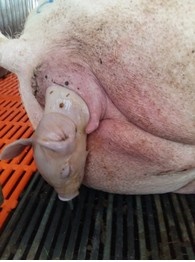
Post-partum Period
What to expect
The postpartum period after the swine's pregnancy and farrowing lasts about 6 weeks after the delivery. Here, you have to tailor your care both to the swine's and the piglets' needs.
To better prepare yourself for the responsibilities, here are a few things that could go wrong that you need to keep an eye out for.
Uterine infections
Uterine infections usually occur when aseptic techniques are not practiced during assisted farrowing. The infections could also be as a result of retained fetal membranes including placenta. The pig will be weak, generally distressed, and may even not want to be around their piglets.
You may also notice a foul-smelling vulval discharge and increased body temperature in the swine.
The infection can be life-threatening if not addressed so make sure to get a vet involved as soon as possible.
Mastitis
Mastitis in swine typically occurs when the piglets bite, scratch, and contaminate the mammary glands when fighting for feeding space. The most telltale sign is a mammary gland teat that is larger than the others. The teat may also be red, bluish, or purple as a result of the inflammation.
Again, urgent vet care is crucial for the swine's wellbeing and that of her newborn piglets by extension.
Piglet neglect
It is not uncommon for swine that deliver large litters of piglets to forget or intentionally ignore one or more of the piglets. This will result in poor growth and sometimes even death to the affected piglets.
Swine aggression and Infanticide
Swine occasionally demonstrate behavior similar to post-partum depression and psychosis. They may get aggressive towards the piglet and even practice infanticide and cannibalism.
It is therefore important to monitor your swine especially the first 2 or 3 days after farrowing for any negative behavior. If the swine poses a danger to the piglets, you may have to move the piglets away and find alternative ways to nurse them.
How to care for the swine
In a nutshell, the best way to take care of a swine and their piglets during the postpartum period is to ensure that they have a clean and stress-free place to nest.
A well-fed and stress-free swine will more often than not take the best possible care of the piglets without any input required on your part.
It is also important to constantly inspect and monitor the swine's mammary glands and vulval discharge for signs of postpartum complications.
